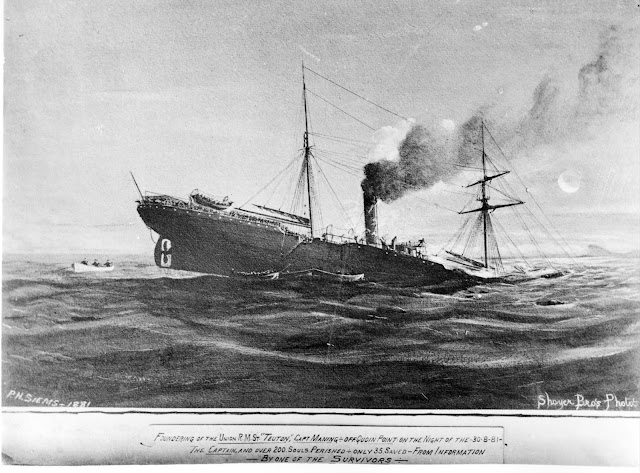SAHRA Maritime and Underwater Cultural Heritage
September 1:
“This day in our shipwreck and aeronautical wreck history”
1902: A great south-easterly storm, resulted in the loss of at least 61 lives, the wrecking of 18 vessels, and the grounding of at least four vessels in Port Elizabeth in the Eastern Cape. This is the greatest loss of vessels in a single event in South African maritime history. The vessels that were refloated include the Coriolanus (1 life lost), the Elliot, the Gabrielle, and the Hans Wagner. An additional four men drowned after their line broke when they attempted to aid some of the vessels from the shore. Many of the vessels wrecked after being driven onto the hulk of the Queen Victoria (1896) which was lying near North End Beach.
• Agostino Rombo, an Italian wooden barque, wrecked after striking the sunken hulk of the Queen Victoria with the loss of life of 7 or 8.
• Arnold, a German iron barque, wrecked at North End beach.
• Cavalieri Michelle Russo/Michael Cavalieri, an Italian steel ship, wrecked at North End beach. Reports vary, on the exact the number of lives lost, but it is believed to have been between 17-19 with only 1 man surviving.
• Clara, a British tug, ran aground and was refloated on the day, but shortly after, the heavy seas ripped its rudder away and its chains were dragged onto North End beach where it became a total wreck.
• Constant, a Norwegian wooden barque, wrecked near the Arnold at North End beach.
• Content, a Norwegian wooden barque, wrecked at the North End beach next to the Emmanuel.
• Countess of Carnarvon, a British wooden steam-powered tug, ran aground and wrecked.
• Emmanuel, a German iron barque, wrecked at the North End beach next to the Content.
• Hermanos, a Norwegian wooden barque, struck the sunken hulk of the Queen Victoria and was wrecked with the loss of two lives.
• Inchcape Rock, a British fully rigged iron ship, wrecked opposite Darling Street and the wreck can be dived on, now lying at about 7m in depth.
• Iris, a German schooner, wrecked at North End beach when its cables parted.
• Limari, a Swedish iron barque, struck the sunken hulk of the Queen Victoria and was wrecked with the loss of 8 lives.
• Nautilus, a German iron barque, first struck the Hans Wagner, then the sunken hulk of the Queen Victoria and eventually the stranded Limari, and was wrecked with the loss of 12 lives.
• Oakworth, a British iron ship, wrecked at North End beach.
• Sayre, a British wooden barque, wrecked at the North End beach.
• Scotia, a British cargo steamer wrecked with the loss of two lives, although it may have been refloated.
• Thekla, a German three-masted wooden schooner wrecked.
• Waimea, a Norwegian iron barque, struck the sunken hulk of the Queen Victoria and was wrecked with the loss of 8 lives.
1965: Claren, this British steam-powered ship was lost in Algoa Bay in the Eastern Cape. Very little is known about it.
1974: Little Nook, this South African yacht wrecked near Durban in KwaZulu-Natal. Very little is known about it.



















